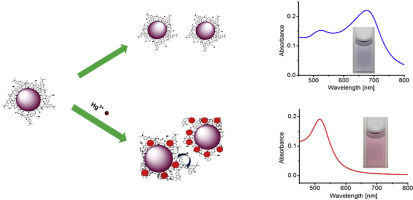Our official English website, www.x-mol.net, welcomes your
feedback! (Note: you will need to create a separate account there.)
Nanozyme-based sensing platforms for detection of toxic mercury ions: An alternative approach to conventional methods.
Talanta ( IF 5.6 ) Pub Date : 2020-03-17 , DOI: 10.1016/j.talanta.2020.120939 Anwarul Hasan 1 , Nadir Mustafa Qadir Nanakali 2 , Abbas Salihi 3 , Behnam Rasti 4 , Majid Sharifi 5 , Farnoosh Attar 6 , Hossein Derakhshankhah 7 , Inaam Ahmad Mustafa 3 , Shang Ziyad Abdulqadir 3 , Mojtaba Falahati 8
Talanta ( IF 5.6 ) Pub Date : 2020-03-17 , DOI: 10.1016/j.talanta.2020.120939 Anwarul Hasan 1 , Nadir Mustafa Qadir Nanakali 2 , Abbas Salihi 3 , Behnam Rasti 4 , Majid Sharifi 5 , Farnoosh Attar 6 , Hossein Derakhshankhah 7 , Inaam Ahmad Mustafa 3 , Shang Ziyad Abdulqadir 3 , Mojtaba Falahati 8
Affiliation

|
Mercury (Hg) is known as a poisonous heavy metal which stimulates a wide range of adverse effects on the human health. Therefore, development of some feasible, practical and highly sensitive platforms would be desirable in determination of Hg2+ level as low as nmol L-1 or pmol L-1. Different approaches such as ICP-MS, AAS/AES, and nanomaterial-based nanobiosensors have been manipulated for determination of Hg2+ level. However, these approaches suffer from expensive instruments and complicated sample preparation. Recently, nanozymes have been assembled to address some disadvantages of conventional methods in the detection of Hg2+. Along with the outstanding progress in nanotechnology and computational approaches, pronounced improvement has been attained in the field of nanozymes, recently. To accentuate these progresses, this review presents an overview on the different reports of Hg2+-induced toxicity on the different tissues followed by various conventional approaches validated for the determination of Hg2+ level. Afterwards, different types of nanozymes like AuNPs, PtNPs for quantitative detection of Hg2+ were surveyed. Finally, the current challenges and the future directions were explored to alleviate the limitation of nanozyme-based platforms with potential engineering in detection of heavy metals, namely Hg2+. The current overview can provide outstanding information to develop nano-based platforms for improvement of LOD and LOQ of analytical methods in sensitive detection of Hg2+ and other heavy metals.
中文翻译:

用于检测有毒汞离子的基于纳米酶的传感平台:传统方法的替代方法。
汞(Hg)被认为是一种有毒的重金属,会刺激多种对人体健康的不利影响。因此,在确定低至nmol L-1或pmol L-1的Hg2 +水平时,需要开发一些可行,实用且高度敏感的平台。已对诸如ICP-MS,AAS / AES和基于纳米材料的纳米生物传感器等不同方法进行了测定Hg2 +水平的操作。然而,这些方法遭受昂贵的仪器和复杂的样品制备的困扰。近来,已经组装了纳米酶以解决常规方法在检测Hg 2+中的一些缺点。随着纳米技术和计算方法的显着进步,近来纳米酶领域已取得了明显的进步。为了突出这些进展,这篇综述介绍了有关Hg2 +诱导的对不同组织毒性的不同报道的概述,随后是经验证可用于确定Hg2 +水平的各种常规方法。之后,调查了用于定量检测Hg2 +的不同类型的纳米酶,如AuNPs,PtNPs。最后,探索了当前的挑战和未来的方向,以减轻基于纳米酶的平台的局限性,该平台在重金属即Hg2 +的检测方面具有潜在的工程技术。当前的概述可以为开发基于纳米的平台,以改善Hg2 +和其他重金属的灵敏检测中分析方法的LOD和LOQ提供出色的信息。
更新日期:2020-03-19
中文翻译:

用于检测有毒汞离子的基于纳米酶的传感平台:传统方法的替代方法。
汞(Hg)被认为是一种有毒的重金属,会刺激多种对人体健康的不利影响。因此,在确定低至nmol L-1或pmol L-1的Hg2 +水平时,需要开发一些可行,实用且高度敏感的平台。已对诸如ICP-MS,AAS / AES和基于纳米材料的纳米生物传感器等不同方法进行了测定Hg2 +水平的操作。然而,这些方法遭受昂贵的仪器和复杂的样品制备的困扰。近来,已经组装了纳米酶以解决常规方法在检测Hg 2+中的一些缺点。随着纳米技术和计算方法的显着进步,近来纳米酶领域已取得了明显的进步。为了突出这些进展,这篇综述介绍了有关Hg2 +诱导的对不同组织毒性的不同报道的概述,随后是经验证可用于确定Hg2 +水平的各种常规方法。之后,调查了用于定量检测Hg2 +的不同类型的纳米酶,如AuNPs,PtNPs。最后,探索了当前的挑战和未来的方向,以减轻基于纳米酶的平台的局限性,该平台在重金属即Hg2 +的检测方面具有潜在的工程技术。当前的概述可以为开发基于纳米的平台,以改善Hg2 +和其他重金属的灵敏检测中分析方法的LOD和LOQ提供出色的信息。











































 京公网安备 11010802027423号
京公网安备 11010802027423号